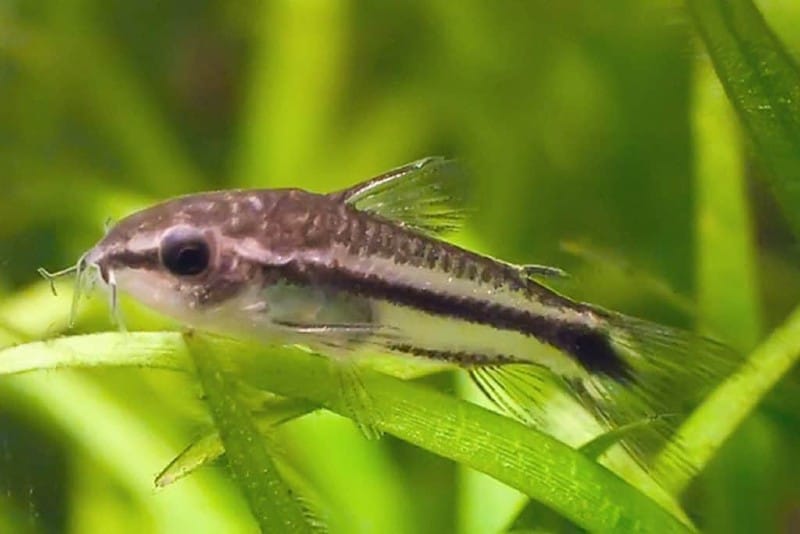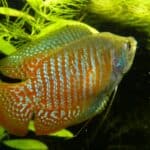Are you into nano fish tanks? If yes, you might want to consider getting Dwarf Corydoras. They are a smaller variety of corydoras that is perfect for small tanks.
They don’t get too big, so they don’t need a lot of space. Plus, these little fish are a great way to add some life and personality to your home without having to put in a lot of work!
Read this complete guide how to learn more about Dwarf Corydoras.
Species Summary

Native to South America, Amazon Basin, Paraguay, and Upper Paraná, Dwarf Corydoras occur in diverse slow-flowing habitats, such as streams and flooded forest areas. They are found along marginal channels, swamps, lakes, temporary ponds, and shallow, clear-to turbid water streams. Some habitats, such as temporary pools, do not contain vegetation, while other places have diverse vegetation.
These fish are hardy and can live in community aquariums with other fish without problems. Even though they come entirely from a collection in a natural environment, It is a very adaptable species that can live in aquariums without any issues. Like other Corydoras, the Dwarf is a shoal species that lives in shoals for around 20 to 50 individuals.
Dwarf Corydoras Care Guide
This section of the guide will cover care requirements for Dwarf Corydoras: tank size, tankmates, same species tanks, water parameters, what to put in their tank, common diseases, food and diet. We’ll include tips for every requirement, so be sure to read on.
Tank Size
This corydoras is an active fish that spends most of its time revolving around the substrate looking for food. Even though they are constantly on the move, it is a species considered great for smaller tanks, known as nano.
Therefore, they should inhabit aquariums over 8 gallons, with dimensions starting at 16″ x 12″ x 12″.
Tank Mates
These little guys are great for beginner fishkeepers, as they are easy to care for and get along well with other fish. Although they are peaceful fish, they should not be kept with aggressive or larger fish that could hurt them. Tetras, Dwarf Shrimps, Bettas, Dwarf Cichlids, Rasbora, and Oto Catfish make great tankmates for the Dwarf Corydoras.
Same Species Tanks
Dwarf Corydoras are rarely used as a single species in any assembly. In any case, it is a suitable species to be kept alone in a well-decorated aquarium in a themed or biotope style.
Water Parameters
Dwarf Corydoras are incredibly resistant fish and can tolerate a wide range of water parameters. However, they are susceptible to pollutants in the water and the accumulation of organic matter in the tank.
The perfect temperature for keeping the Dwarf Corydoras in an aquarium is 68 to 86 degrees Fahrenheit. The ideal pH range is between 6.0 and 7.6.
Dwarf Corydoras are also suitable fish for beginner aquarists due to their rusticity.
One thing to keep in mind is that the difference between hardness and pH is related to the region of origin of the specimen. This means that the parameters may fluctuate during the dry and rainy seasons.
What to Put in Their Tank
One of the most important things you need to do is to make sure your tank has a heater. Corydoras Catfish are tropical fish, so they need warm water to thrive.
Another important thing to do is to make sure your tank has a filter. Corydoras Catfish are very sensitive to water quality, so a good filter is essential. A good filter will help keep the water clean and toxins-free.
Finally, you need to make sure your tank has plenty of hiding places. A good way to provide hiding places is to use fine sand ponds with driftwood and a bed of dry leaves.
Fine sand substrate is recommended. Otherwise, substrates with edges and angles can hurt the fish.
Common Diseases
They are remarkably disease-resistant fish. Keeping the water and the tank quality always in optimal conditions and a good quality diet, your fish should not present any problem. Remember to always quarantine new fish before placing them in the main aquarium.
Food and Diet
These fish are omnivorous. Like most Corydoras, they will eat food that settles at the bottom of the aquarium. In their natural habitat, they feed on worms, crustaceans, insects, and plant matter in the wild. Its consumption will depend heavily on what’s available in its surroundings.
In an aquarium, these fish readily accept all types of food. Unfortunately, these fish are wrongly labelled as cleaner fish and feed on leftover feed and feces from other fish. Under no circumstances should they be expected to survive on ‘leftovers’ from other aquarium inhabitants, let alone the wastes of other fish. Appropriate food should be provided regularly, including specific bottom fish feeds and live food.
Lifespan
It is not uncommon for a Dwarf Corydoras to live for more than five years in an aquarium. The lifespan of a Dwarf Corydoras in the wild is considerably shorter, though, as these animals are more susceptible to diseases, attacks from other animals, and environmental causes.
Appearance
The Dwarf Corydoras has the classic shape of other Corydoras species, but its body is typically more elongated than other Corydoras species. It is also translucent white to slightly olive in color with a thin dark stripe on the sides of its body. Also, it has a white coloration at the base of the tail around a black spot.
Size
They can quickly grow to 1,2 inches in length when well cared for and fed, but the everyday sight is around 0.8 inches.
Behavior and Temperament
These fish are very active, constantly grazing on the substrate and observing their surroundings. They are schooling fish, so it is best to keep them in groups of four.
Additionally, it is one of the few species of bottom fish that enjoys swimming in mid-water. Due to its ability to breathe atmospheric air, it can commonly be seen swimming quickly to the surface to gulp air and come back down to rest.
Interestingly enough, the Dwarf Cory is known to “blink” their eyes when the eyes rotate in their sockets, causing the appearance of blinking.
Breeding
Breeding Dwarf Corydoras is not tricky: these fish reproduce similarly to countless other species of Corydoras. They are oviparous, which means that the female will hold a few eggs between her pelvic fins. The male will then fertilize them in a movement that lasts about 30 seconds.
After fertilizing, the female will take the sticky eggs to a previously chosen location, usually on leaves or flat surfaces. The pair will repeat this process every three minutes for one to two hours, with 10 to 15 minute rests between laying eggs. Around 7 to 15 eggs are spawned daily, and spawning can take three to four days.
Note that a single female can generate 30 to 60 eggs over this period, and the eggs hatch in 3-9 days.
Gender Differences: Male vs Female
One thing that you may not know about Corydoras is that there are some noticeable differences between the males and females. For one, males are generally smaller and thinner than females. They also have a more pointed dorsal fin.
Females, on the other hand, are usually slightly larger and fatter. You can easily tell the difference between the two sexes when you look at them from above, as the females will have a more prominent and rounded belly.
Dwarf Corydoras Fun facts
● This species, along with C. pygmaeus and C. habrosus are commonly referred to as Dwarf Corydoras.
● C. hastatus can be confused with C. pygmaeus, but they are easily distinguished by the color pattern, since in C. hastatus there is a dark diamond-shaped spot on the caudal peduncle, while in C. pygmaeus it is absent. The latter features a dark side stripe on its flanks.
● Their morphological displays and adaptations such as large eyes, terminal position of the mouth, body shape (more symmetrical than other Corydoras) and caudal fin indicate that they live in pelagic areas. This behavior can be seen when kept in an aquarium, where they prefer to spend most of their time swimming in mid-water rather than staying close to the bottom, an unusual behavior in most Corydoras. Other Dwarf Corydoras species such as C. habrosus and C. pygmaeu have the same habit, maintaining their position in mid-water normally using the current to stay in position.
● This behavior also allows them to form large aggregations with other similar fish species such as small characids Serrapinnus kriegi, Aphyocharax nattereri and Hyphessobrycon elachys. This phenomenon of joining multiple species of similar shapes and colors is common in the genus, although it is usually demonstrated by sympatric Corydoras species that maintain the same pattern.
The reason for this behavior is to protect themselves from predators and also to look for food taking advantage of being in a larger group and consequently exploring contrasting ecological niches.
References
Britski, H.A., K.Z. de S> de Silimon and B.S. Lopes, 2007. Peixes do Pantanal: manual de identificaçäo, 2 ed. re. ampl. Brasília, DF: Embrapa Informaçäo Tecnológica, 227 p.
Burgess, W.E., 1992. Colored atlas of miniature catfish. Every species of Corydoras, Brochis and Aspidoras. T.F.H. Publications, Inc., USA. 224 p.
Nomura, H., 1984. Nomes científicos dos peixes e seus correspondentes nomes vulgares. In H. Nomura (ed.). Dicionário dos peixes do Brasil. Editerra, Brasília, Brasil: 27-63.
Robins, C.R., R.M. Bailey, C.E. Bond, J.R. Brooker, E.A. Lachner, R.N. Lea and W.B. Scott, 1991. World fishes important to North Americans. Exclusive of species from the continental waters of the United States and Canada. Am. Fish. Soc. Spec. Publ. (21):243 p.
Skelton, P.H., 2001. A complete guide to the freshwater fishes of southern Africa. Cape Town (South Africa): Struik Publishers, 395 p.








